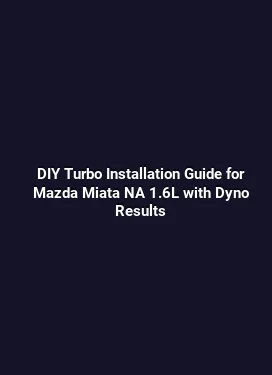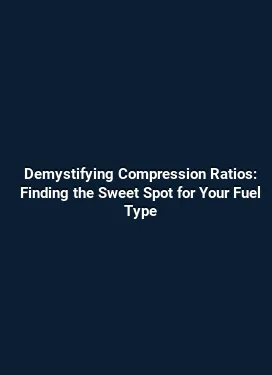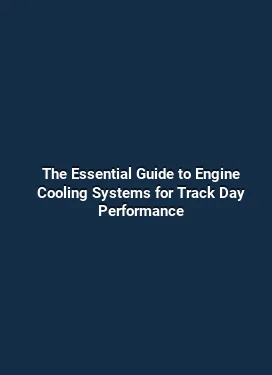Best Turbo Manifold Materials: Cast Iron vs Stainless Steel Comparison
Material Fundamentals and Heat Management

Turbo manifolds sit at the critical junction where exhaust energy is converted into boosted pressure. The material choice influences heat retention, thermal cycling, and the ability to sustain high exhaust temperatures without warping or cracking. Cast iron and stainless steel each bring distinct thermal profiles to the table, shaping how quickly heat is absorbed, how evenly it spreads, and how the surface interacts with gaskets and mounting hardware. In performance applications, understanding these thermal dynamics helps engineers and enthusiasts predict spall resistance, heat soak, and the potential for heat-related fatigue under sustained boost and high RPMs.
When evaluating heat management, several factors come into play: thermal conductivity, specific heat capacity, emissivity, and the geometry of the manifold itself. Cast iron generally exhibits lower thermal conductivity than stainless steel, which can translate to more heat staying close to the exhaust ports. This characteristic can benefit exhaust gas velocity near the turbine inlet but may amplify heat soak in surrounding engine bays. Stainless steel, especially in a polished or coated form, tends to transfer heat more efficiently away from the core and into the surrounding environment, potentially reducing heat-induced distortion and helping with under-hood temperatures. The practical implication is that stainless manifolds may help with turbocharger thermal stability during aggressive driving, while cast iron may offer superior resistance to cracking and warping when subjected to extreme thermal cycling over long service intervals.
Cast Iron Characteristics and Suitability

Cast iron manifolds are renowned for their high resistance to thermal shock and excellent durability under heavy exhaust loads. The microstructure of cast iron, often with a graphite-rich matrix, provides resilience against cracking that can occur when rapid temperature fluctuations occur during cold starts or fast throttle transitions. For turbo kits that prioritize reliability in high-heat environments or for engines that frequently operate at elevated exhaust gas temperatures, cast iron can be a favorable baseline material. Additionally, cast iron is typically more economical in raw material cost, which can be a practical consideration for builds focused on value and long-term reliability.
However, the heavier weight of cast iron and its relatively lower thermal conductivity can influence turbo spool characteristics and under-hood heat management. In engines with tight packaging or in street-driven platforms, the heavier mass may necessitate careful mounting, heat shielding, and consideration of gasket sealing strategies to prevent leaks over time. Cast iron manifolds also require robust flange mating and attention to the durability of studs and nuts, as the material tends to retain heat and may affect bolt preload if thermal cycling is extreme.
Stainless Steel Characteristics and Suitability
Stainless steel manifolds, particularly those made from 304 or 409 alloy families, bring notable advantages in weight reduction and corrosion resistance. The higher thermal conductivity of stainless steel allows heat to be conducted away from critical junctions more readily, which can contribute to reduced likelihood of heat-induced warping and improved thermal stability under demanding driving conditions. For modern turbo setups that emphasize lighter weight, faster part response, and enhanced endurance in road or track use, stainless steel provides a compelling balance between performance and longevity.
For enthusiasts pursuing aggressive tuning, stainless steel also enables more complex geometries and tighter tolerances in the runner layout. The material’s formability supports precision casting or welding techniques that can optimize runner bends, flange alignment, and smooth internal transitions to minimize exhaust flow disturbances. Coatings, such as ceramic or high-temperature ceramic-like finishes, can further reduce emissivity and protect the surface from oxidation, though coating selection should be aligned with the intended service environment and cleaning practices to avoid coating delamination at high temperatures.
Performance Implications and Real-World Applications
Material selection for a turbo manifold directly impacts how exhaust energy is delivered to the turbine wheel, and by extension, how quickly the system achieves boost, maintains it, and recovers during throttle modulation. The practical performance differences stem from the interplay of thermal behavior, mechanical strength, and the manifold’s ability to resist deformation under pressure. Real-world data suggest that while stainless steel can provide improved spool and mid-range response due to more effective heat management, cast iron can deliver trustworthy long-term durability under persistent high-heat environments. The choice often depends on the intended use case: daily driving with consistent heat cycles vs. high-performance track sessions with sustained boost and rapid temperature swings.
Understanding how each material behaves under different boost targets helps builders tailor the manifold to the engine’s breathing characteristics. A high-flow design with shorter runners and optimized primaries may benefit from stainless steel’s thermal properties, enabling consistent turbine inlet temperatures and stable exhaust gas flow into the turbine housing. Conversely, a cast iron manifold can be advantageous when the goal is maximum durability in engines that repeatedly operate at high EGTs and are subject to long idle periods followed by rapid acceleration, such as endurance racing or certain off-road applications where ruggedness is paramount.
Thermal Conductivity and Heat Dissipation
Thermal conductivity is a key differentiator between the two materials. Stainless steel’s higher conductivity means heat travels more quickly through the manifold walls, which helps in spreading thermal energy away from critical interfaces and reducing hotspot formation. In practice, this can lower the risk of warping at flange joints and reduce heat creep toward adjacent components like oxygen sensors and wiring looms. However, faster heat transfer can also raise the overall under-hood temperature if cooling provisions are insufficient, which is why heat shielding and exhaust wrap are common companions to stainless manifolds in performance builds.
Cast iron’s lower thermal conductivity helps confine heat within the exhaust path for slightly longer. This can contribute to higher localized exhaust gas temperatures at the turbine inlet, potentially aiding turbine efficiency in certain configurations. The downside is a greater tendency for heat to accumulate near the engine, increasing the likelihood of warping or cracking if cooling is inadequate or the component is exposed to extreme cycling. For tuners, pairing a cast iron manifold with robust heat management strategies—such as a well-placed turbo blanket, heat shields, and strategic wrap—can mitigate these risks while preserving durability.
Weight, Stress, and Durability
Weight differences between cast iron and stainless steel can influence vehicle dynamics, particularly in performance and race-oriented builds where every kilogram matters. Stainless steel typically offers a lighter option with similar or greater strength-to-weight ratios, contributing to improved acceleration and handling characteristics in weight-sensitive platforms. Cast iron’s robustness translates into excellent resistance to mechanical impact and long-term fatigue, making it a dependable choice in environments where heat cycles are severe and maintenance windows are limited.
From a stress perspective, the coefficient of thermal expansion plays a role. Stainless steel expands and contracts more than cast iron with temperature changes, which can affect flange seals and gasket life under rapid boost transitions. This is why selecting compatible gaskets, fasteners, and proper torque specifications is essential when switching material types. Real-world installations often require recalibrating torque sequences and rechecking flange alignment after a few heat cycles to ensure consistent seal integrity under boost pressure.
Engine Performance and Tuning Considerations
Choosing between cast iron and stainless steel isn’t solely about heat. It also ties into how an engine breathes, how the exhaust manifold integrates with the turbine housing, and how the system behaves under different driving modes. A well-muned turbo manifold must align with the turbine boost curve, exhaust backpressure, and the engine’s volumetric efficiency to deliver the intended power band. Stainless steel manifolds often pair well with modern, high-flow turbochargers and aggressive tuning strategies because their heat management characteristics support stable turbine inlet temperatures during rapid boost ramping. Cast iron manifolds may be favored in setups where durability, cost efficiency, and predictable behavior under high thermal stress are prioritized, especially in long-duration usage scenarios where maintenance is less frequent.
In practical terms, the manifold material interacts with other components such as the downpipe, catalytic system, and heat management accessories. For example, a stainless manifold may benefit more from ceramic coatings that suppress radiant heat, enabling cooler under-hood temperatures and longer sensor life. Conversely, cast iron manifolds can be paired with strategic insulation to maintain a protective thermal boundary without adding excessive mass. When evaluating a build’s goals—street, track, or endurance—the material decision should harmonize with the turbocharger sizing, exhaust routing, and the anticipated maintenance plan to achieve the desired power delivery and reliability.
Cost, Availability, and Long-Term Reliability
Cost is a practical lens through which to view material choice. Cast iron manifolds generally present a lower initial outlay and simpler repair options, especially for platforms where parts compatibility is key and aftermarket support is robust. Stainless steel manifolds, while potentially pricier upfront, can offer longer service intervals in high-heat environments and better corrosion resistance in wet or humid climates. Availability is another consideration; modern performance markets typically stock a wide range of stainless steel options with various runner counts and flange configurations, enabling more precise tailoring to engine displacement and boost targets.
Reliability hinges on a combination of material properties, manufacturing quality, and maintenance practices. Stainless steel manifolds, when properly coated and shielded, can resist oxidation and thermal fatigue, contributing to reduced risk of cracking under repeated thermal cycling. Cast iron manifolds, with their inherent durability, excel in resisting surface cracking but may require attentive heat management to prevent warping. Regardless of material, choosing a reputable manufacturer, verifying flange flatness, and inspecting welds for consistency are essential steps in ensuring long-term performance and avoiding leaks that would compromise turbine efficiency and engine performance.
Installation Considerations and Practical Tips
Installation quality matters as much as material choice. Proper flange alignment, clean mating surfaces, and correct gasket selection are fundamental to achieving a leak-free connection and maintaining exhaust gas flow. With cast iron manifolds, the heavier weight can place greater demand on mounting hardware and brackets; ensuring hardware is rated for higher load and using heat-resistant fasteners can mitigate stress on the flange over time. Stainless steel manifolds benefit from precision machining and smoother runner transitions, but the lighter mass can mask micro-misalignment issues that would otherwise cause gasket leaks if not addressed during installation.
To maximize performance and durability, consider the following practical steps: verify connector compatibility with the turbo flange pattern, confirm runner lengths match the engine’s breathing characteristics, and evaluate the need for heat management accessories such as wraps, shields, and reflective coatings. While stainless manifolds may support tighter geometry, their higher expansion rate necessitates rechecking flange torque after the first few heat cycles. For cast iron options, inspect the weld quality, ensure proper post-fabrication annealing where applicable, and monitor for any signs of microcracking after extended use. A well-planned installation, combined with a thoughtful heat management strategy, often yields the most consistent results across road and track environments.
Material Selection Guide for Different Applications
Designers and enthusiasts often segment the decision by application type. Street-driven builds that require a balance between daily usability, longevity, and modest boost targets may benefit from a durable cast iron manifold paired with conservative heat shielding. For enthusiasts pursuing aggressive performance, frequent dyno runs, or track days where boost and temperature demands are high, a stainless steel manifold with optimized runner geometry and a coating strategy can deliver improved throttle response and sustained turbine efficiency. In off-road or endurance contexts where resilience against vibration, shocks, and dust exposure matters, the robustness of cast iron can be a decisive factor. Ultimately, the best choice aligns with the engine’s architecture, the turbo system’s staging, and the owner’s maintenance philosophy.
Emerging trends in manifold design emphasize hybrids and advanced alloys that blend the benefits of both materials. For example, some builders explore composite approaches where stainless steel runners are joined to a cast-iron collector, balancing lightness and durability. Another trend involves enhanced finish options, such as satin finishes or ceramic-like coatings, to reduce emissivity and mitigate under-hood heat buildup without compromising exhaust flow. These innovations illustrate how material science continues to influence turbo performance, offering more nuanced solutions tailored to specific engines, boost curves, and regulatory environments.
In summary, the best turbo manifold material for a given build depends on a careful assessment of heat management needs, durability expectations, and the desired balance between weight and cost. By examining thermal properties, structural behavior under boost, and the installation realities of each material, you can select a manifold that maximizes turbine efficiency, supports reliable long-term operation, and aligns with your tuning ambitions. Keeping an eye on real-world feedback from similar engine configurations can also provide practical guidance as you refine your setup for predictable power delivery and consistent performance across the vehicle’s RPM range.






